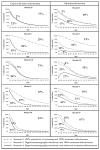Comparing CISNET Breast Cancer Models Using the Maximum Clinical Incidence Reduction Methodology
- PMID: 29554471
- PMCID: PMC5862068
- DOI: 10.1177/0272989X17743244
Comparing CISNET Breast Cancer Models Using the Maximum Clinical Incidence Reduction Methodology
Abstract
Background: Collaborative modeling has been used to estimate the impact of potential cancer screening strategies worldwide. A necessary step in the interpretation of collaborative cancer screening model results is to understand how model structure and model assumptions influence cancer incidence and mortality predictions. In this study, we examined the relative contributions of the pre-clinical duration of breast cancer, the sensitivity of screening, and the improvement in prognosis associated with treatment of screen-detected cases to the breast cancer incidence and mortality predictions of 5 Cancer Intervention and Surveillance Modeling Network (CISNET) models.
Methods: To tease out the impact of model structure and assumptions on model predictions, the Maximum Clinical Incidence Reduction (MCLIR) method compares changes in the number of breast cancers diagnosed due to clinical symptoms and cancer mortality between 4 simplified scenarios: 1) no-screening; 2) one-time perfect screening exam, which detects all existing cancers and perfect treatment (i.e., cure) of all screen-detected cancers; 3) one-time digital mammogram and perfect treatment of all screen-detected cancers; and 4) one-time digital mammogram and current guideline-concordant treatment of all screen-detected cancers.
Results: The 5 models predicted a large range in maximum clinical incidence (19% to 71%) and in breast cancer mortality reduction (33% to 67%) from a one-time perfect screening test and perfect treatment. In this perfect scenario, the models with assumptions of tumor inception before it is first detectable by mammography predicted substantially higher incidence and mortality reductions than models with assumptions of tumor onset at the start of a cancer's screen-detectable phase. The range across models in breast cancer clinical incidence (11% to 24%) and mortality reduction (8% to 18%) from a one-time digital mammogram at age 62 y with observed sensitivity and current guideline-concordant treatment was considerably smaller than achievable under perfect conditions.
Conclusions: The timing of tumor inception and its effect on the length of the pre-clinical phase of breast cancer had a substantial impact on the grouping of models based on their predictions for clinical incidence and breast cancer mortality reduction. This key finding about the timing of tumor inception will be included in future CISNET breast analyses to enhance model transparency. The MCLIR approach should aid in the interpretation of variations in model results and could be adopted in other disease screening settings to enhance model transparency.
Keywords: breast cancer natural history assumptions; maximum clinical incidence reduction; screening effectiveness.
Figures




Similar articles
-
Comparing CISNET Breast Cancer Incidence and Mortality Predictions to Observed Clinical Trial Results of Mammography Screening from Ages 40 to 49.Med Decis Making. 2018 Apr;38(1_suppl):140S-150S. doi: 10.1177/0272989X17718168. Med Decis Making. 2018. PMID: 29554468 Free PMC article.
-
The Impact of Different Screening Model Structures on Cervical Cancer Incidence and Mortality Predictions: The Maximum Clinical Incidence Reduction (MCLIR) Methodology.Med Decis Making. 2020 May;40(4):474-482. doi: 10.1177/0272989X20924007. Epub 2020 Jun 3. Med Decis Making. 2020. PMID: 32486894 Free PMC article.
-
Common Model Inputs Used in CISNET Collaborative Breast Cancer Modeling.Med Decis Making. 2018 Apr;38(1_suppl):9S-23S. doi: 10.1177/0272989X17700624. Med Decis Making. 2018. PMID: 29554466 Free PMC article.
-
Digital Breast Tomosynthesis with Hologic 3D Mammography Selenia Dimensions System for Use in Breast Cancer Screening: A Single Technology Assessment [Internet].Oslo, Norway: Knowledge Centre for the Health Services at The Norwegian Institute of Public Health (NIPH); 2017 Sep 4. Report from the Norwegian Institute of Public Health No. 2017-08. Oslo, Norway: Knowledge Centre for the Health Services at The Norwegian Institute of Public Health (NIPH); 2017 Sep 4. Report from the Norwegian Institute of Public Health No. 2017-08. PMID: 29553669 Free Books & Documents. Review.
-
Reflecting on 20 years of breast cancer modeling in CISNET: Recommendations for future cancer systems modeling efforts.PLoS Comput Biol. 2021 Jun 17;17(6):e1009020. doi: 10.1371/journal.pcbi.1009020. eCollection 2021 Jun. PLoS Comput Biol. 2021. PMID: 34138842 Free PMC article. Review.
Cited by
-
Benefits and harms of annual, biennial, or triennial breast cancer mammography screening for women at average risk of breast cancer: a systematic review for the European Commission Initiative on Breast Cancer (ECIBC).Br J Cancer. 2022 Mar;126(4):673-688. doi: 10.1038/s41416-021-01521-8. Epub 2021 Nov 26. Br J Cancer. 2022. PMID: 34837076 Free PMC article.
-
Comparing CISNET Breast Cancer Incidence and Mortality Predictions to Observed Clinical Trial Results of Mammography Screening from Ages 40 to 49.Med Decis Making. 2018 Apr;38(1_suppl):140S-150S. doi: 10.1177/0272989X17718168. Med Decis Making. 2018. PMID: 29554468 Free PMC article.
-
The Impact of Different Screening Model Structures on Cervical Cancer Incidence and Mortality Predictions: The Maximum Clinical Incidence Reduction (MCLIR) Methodology.Med Decis Making. 2020 May;40(4):474-482. doi: 10.1177/0272989X20924007. Epub 2020 Jun 3. Med Decis Making. 2020. PMID: 32486894 Free PMC article.
-
Clinical Benefits, Harms, and Cost-Effectiveness of Breast Cancer Screening for Survivors of Childhood Cancer Treated With Chest Radiation : A Comparative Modeling Study.Ann Intern Med. 2020 Sep 1;173(5):331-341. doi: 10.7326/M19-3481. Epub 2020 Jul 7. Ann Intern Med. 2020. PMID: 32628531 Free PMC article.
-
Introduction to the Cancer Intervention and Surveillance Modeling Network (CISNET) Breast Cancer Models.Med Decis Making. 2018 Apr;38(1_suppl):3S-8S. doi: 10.1177/0272989X17737507. Med Decis Making. 2018. PMID: 29554472 Free PMC article.
References
-
- Lee SJ, Li X, Huang H. Models for Breast Cancer Screening Strategies Updated for Ductal Carcinoma In Situ and Subgroups Medical Decision Making. 2017 In Press.
-
- van den Broek JJ, van Ravesteyn NT, Heijnsdijk EA, de Koning HJ. Estimating the effects of risk-based screening and adjuvant treatment using the MISCAN-Fadia continuous tumor growth model for breast cancer. Medical Decision Making. 2017 In Press.
-
- Huang X, Li Y, Song J, Berry DA. The MD Anderson CISNET Model for Estimating Benefits of Adjuvant Therapy and Screening Mammography for Breast Cancer: An Update. Medical Decision Making. 2017 In Press.
Publication types
MeSH terms
Grants and funding
LinkOut - more resources
Full Text Sources
Other Literature Sources
Medical

